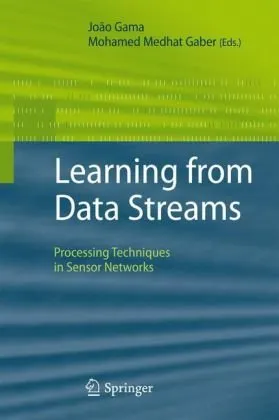Learning from Data Streams: Processing Techniques in Sensor Networks
4.5
Reviews from our users

You Can Ask your questions from this book's AI after Login
Each download or ask from book AI costs 2 points. To earn more free points, please visit the Points Guide Page and complete some valuable actions.Introduction to Learning from Data Streams: Processing Techniques in Sensor Networks
In today's era of advancing technologies, the ever-growing streams of data challenge how we interpret, process, and extract meaningful insights. Learning from Data Streams: Processing Techniques in Sensor Networks dives deep into the concept of streaming data and equips the readers with groundbreaking methodologies to analyze high-speed, continuous, and unbounded data flows. The book is particularly relevant in the context of sensor networks, where real-time data requirements are critical for decision-making. By addressing core challenges and presenting scalable solutions, this book stands as a cornerstone of knowledge for researchers, professionals, and students in data science, machine learning, and sensor technologies.
Detailed Summary of the Book
The book offers a comprehensive exploration of data streams, a paradigm increasingly adopted in dynamic environments where traditional batch processing methods fall short. It begins by introducing the unique characteristics of streaming data — fast, continuous, and often unstructured. The emphasis is placed on the challenges faced when applying conventional data mining techniques, which are better suited for static datasets.
A major portion of the book focuses on algorithms and architectures specifically designed for stream processing. From adaptive models and incremental learning to lightweight algorithms for resource-constrained devices, the book introduces a wide array of techniques. It also dedicates key chapters to anomaly detection, clustering, and classification techniques in the context of high-speed data processing in sensor networks.
By blending theoretical underpinnings with practical applications, the book helps bridge the gap between research and real-world tasks. It also explores how sensor networks produce a deluge of data streams and discusses methods for efficient data collection, preprocessing, and mining within these networks.
Finally, the book culminates with advanced topics such as concept drift detection, distributed computing for stream processing, and handling uncertainty within dynamic systems. Rounded out with real-life use cases and case studies, this book is an invaluable resource for anyone venturing into the exciting field of data streams and sensor networks.
Key Takeaways
- Understand the unique challenges and characteristics of data streams compared to traditional batch processing.
- Learn cutting-edge techniques for mining, clustering, and classification over dynamic and high-speed data.
- Explore how sensor networks generate real-time streams and how to process them efficiently.
- Grasp advanced topics like concept drift, incremental learning, and adapting to changing environments.
- Apply theoretical knowledge through real-world case studies and applications in sensor-driven systems.
Famous Quotes from the Book
"A data stream does not wait for us to analyze its information; it arrives unpredictably and infinitely, requiring us to think beyond static processing."
"The true power of data streams lies not in merely collecting data but in transforming it into actionable insights, often in real-time."
"Handling concept drift is not an option—it’s a necessity in any environment influenced by change."
Why This Book Matters
In a world increasingly driven by IoT, smart devices, and sensor-related technologies, data streams have become an essential ecosystem. Their unbounded and real-time nature means they are now highly relevant across industries like healthcare, environmental monitoring, finance, and autonomous systems. Traditional data processing and mining frameworks are not built to handle the dynamic complexity associated with these streams.
This book fills the knowledge gap by not only explaining the "what" and "why" of data streams but also diving deep into the "how." Its focus on adaptive and resource-efficient solutions makes it applicable for professionals working on constrained devices such as sensors. Moreover, for researchers and students, it lays a robust foundation for tackling frontier challenges in data science and applied machine learning.
The book’s versatile insights, coupled with actionable frameworks, ensure that it is more than just an academic resource; it’s a manual for innovation, enabling readers to unlock the potential of data streams and sensor networks in today’s fast-paced data landscape.
Free Direct Download
You Can Download this book after Login
Accessing books through legal platforms and public libraries not only supports the rights of authors and publishers but also contributes to the sustainability of reading culture. Before downloading, please take a moment to consider these options.
Find this book on other platforms:
WorldCat helps you find books in libraries worldwide.
See ratings, reviews, and discussions on Goodreads.
Find and buy rare or used books on AbeBooks.
1202
بازدید4.5
امتیاز50
نظر98%
رضایتReviews:
4.5
Based on 0 users review
"کیفیت چاپ عالی بود، خیلی راضیام"


